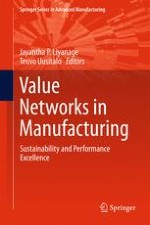2017 | OriginalPaper | Chapter
Towards Sustainability Governance in Value Networks
Authors : Katri Valkokari, Padmakshi Rana
Published in: Value Networks in Manufacturing
Publisher: Springer International Publishing
Activate our intelligent search to find suitable subject content or patents.
Select sections of text to find matching patents with Artificial Intelligence. powered by
Select sections of text to find additional relevant content using AI-assisted search. powered by
